ENTREPRENEURSHIP AND SMES: Analyzing Spice Sky Restaurant's Issues
VerifiedAdded on 2020/04/15
|21
|5588
|384
Report
AI Summary
This report focuses on the entrepreneurial challenges faced by the Spice Sky restaurant, a well-known Indian restaurant in London, which has experienced a decline in sales. The report identifies the problems, including menu changes, inadequate promotional activities, and a lack of digital presence. It applies various theories such as PESTLE analysis, Porter's five forces, and competitive analysis to understand the external and competitive environment. The analysis reveals the restaurant's strengths and weaknesses, particularly in digital marketing and innovation. The report recommends strategies such as enhancing digital marketing, expanding the menu, and improving customer engagement to address the issues. The conclusion emphasizes the need for the restaurant to adapt to market changes and improve its competitive position.
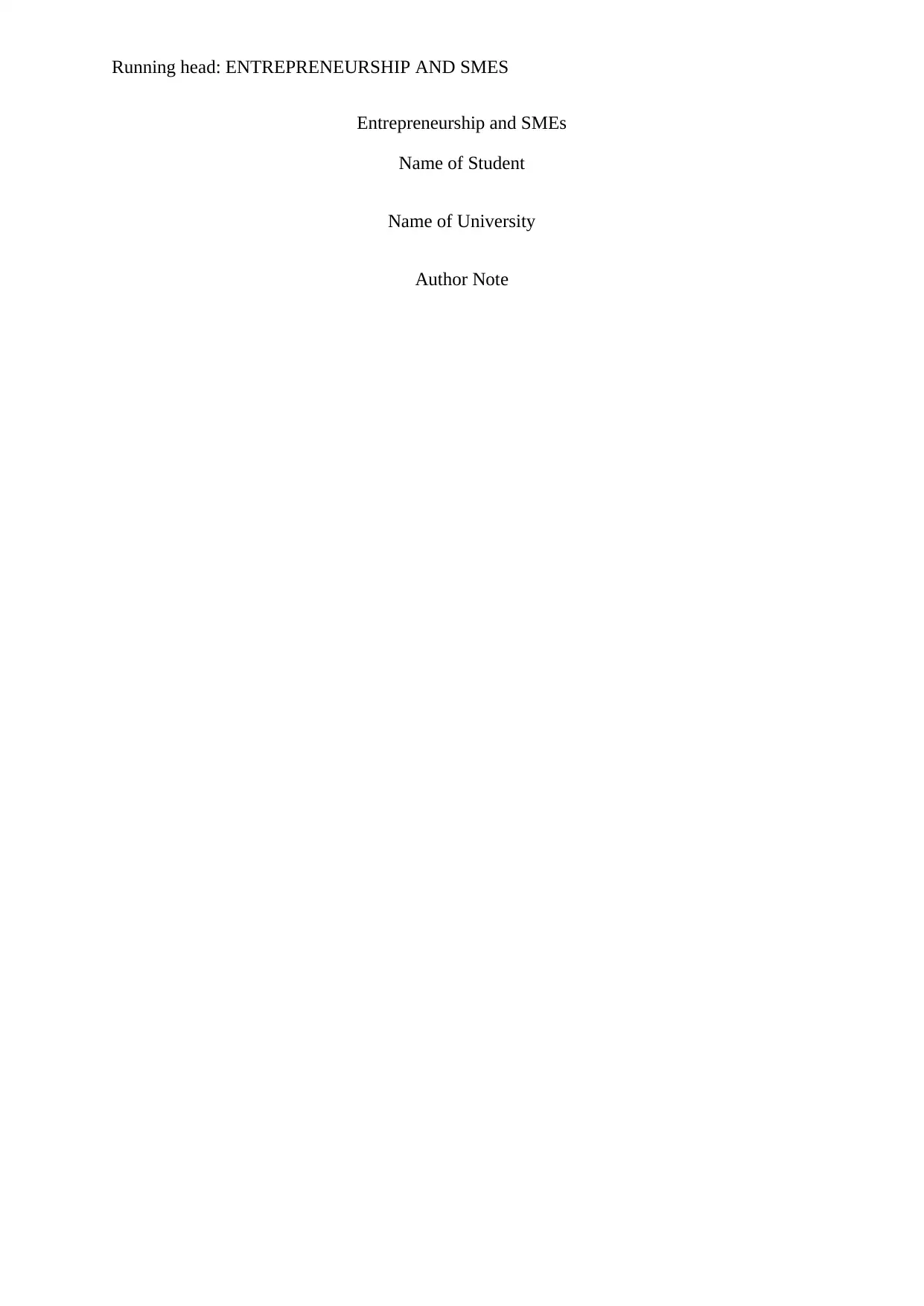
Running head: ENTREPRENEURSHIP AND SMES
Entrepreneurship and SMEs
Name of Student
Name of University
Author Note
Entrepreneurship and SMEs
Name of Student
Name of University
Author Note
Paraphrase This Document
Need a fresh take? Get an instant paraphrase of this document with our AI Paraphraser
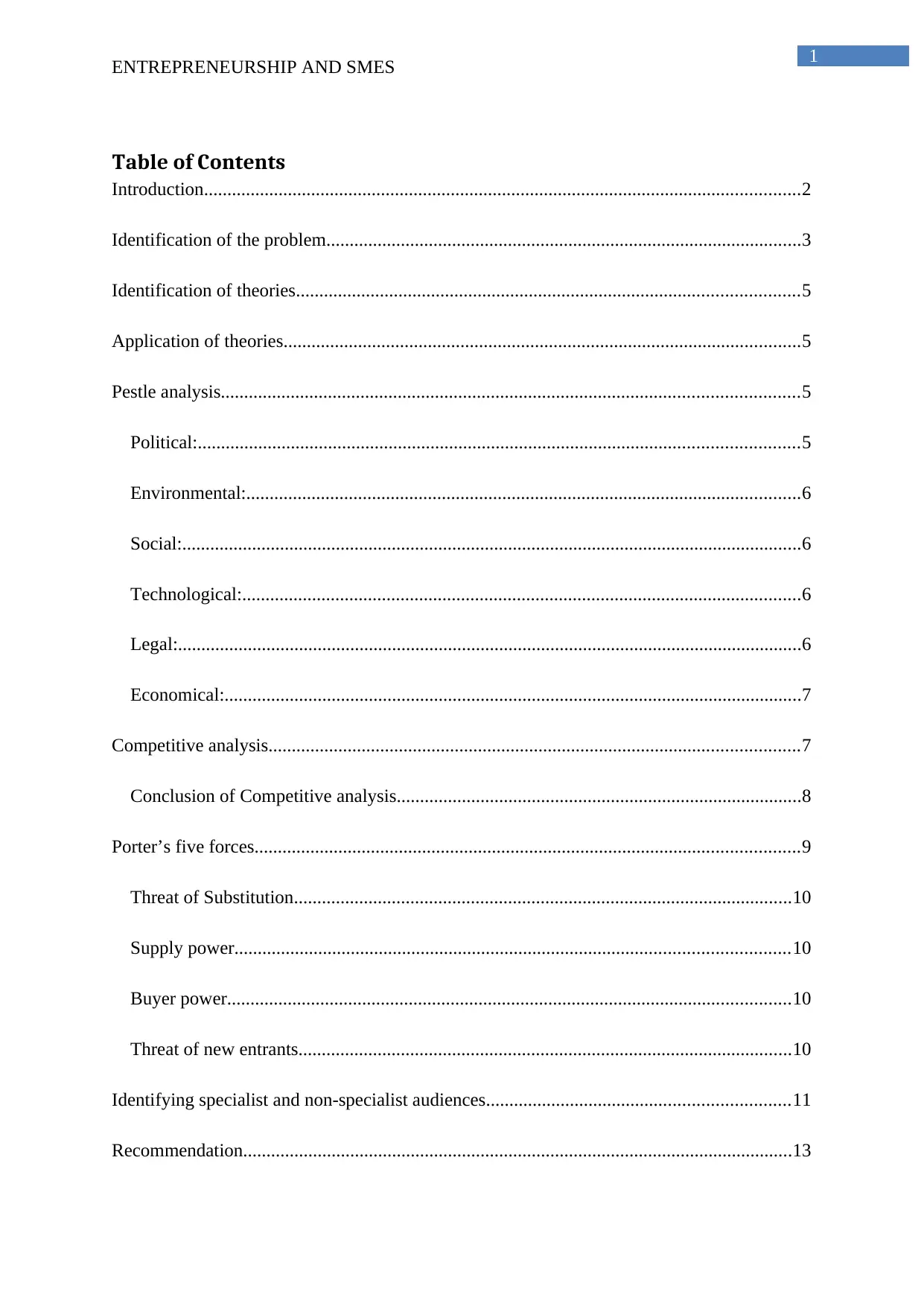
1
ENTREPRENEURSHIP AND SMES
Table of Contents
Introduction................................................................................................................................2
Identification of the problem......................................................................................................3
Identification of theories............................................................................................................5
Application of theories...............................................................................................................5
Pestle analysis............................................................................................................................5
Political:.................................................................................................................................5
Environmental:.......................................................................................................................6
Social:.....................................................................................................................................6
Technological:........................................................................................................................6
Legal:......................................................................................................................................6
Economical:............................................................................................................................7
Competitive analysis..................................................................................................................7
Conclusion of Competitive analysis.......................................................................................8
Porter’s five forces.....................................................................................................................9
Threat of Substitution...........................................................................................................10
Supply power.......................................................................................................................10
Buyer power.........................................................................................................................10
Threat of new entrants..........................................................................................................10
Identifying specialist and non-specialist audiences.................................................................11
Recommendation......................................................................................................................13
ENTREPRENEURSHIP AND SMES
Table of Contents
Introduction................................................................................................................................2
Identification of the problem......................................................................................................3
Identification of theories............................................................................................................5
Application of theories...............................................................................................................5
Pestle analysis............................................................................................................................5
Political:.................................................................................................................................5
Environmental:.......................................................................................................................6
Social:.....................................................................................................................................6
Technological:........................................................................................................................6
Legal:......................................................................................................................................6
Economical:............................................................................................................................7
Competitive analysis..................................................................................................................7
Conclusion of Competitive analysis.......................................................................................8
Porter’s five forces.....................................................................................................................9
Threat of Substitution...........................................................................................................10
Supply power.......................................................................................................................10
Buyer power.........................................................................................................................10
Threat of new entrants..........................................................................................................10
Identifying specialist and non-specialist audiences.................................................................11
Recommendation......................................................................................................................13
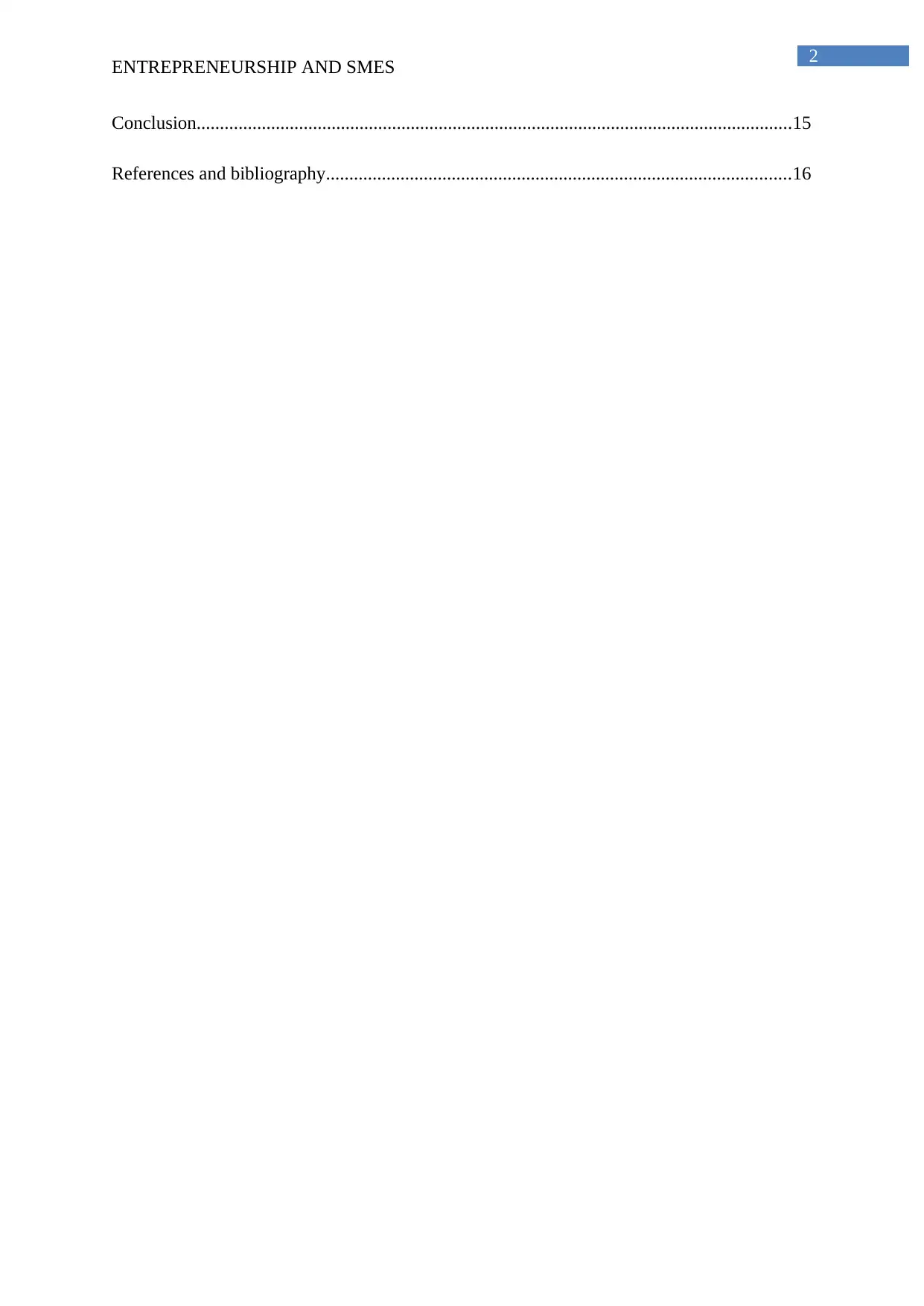
2
ENTREPRENEURSHIP AND SMES
Conclusion................................................................................................................................15
References and bibliography....................................................................................................16
ENTREPRENEURSHIP AND SMES
Conclusion................................................................................................................................15
References and bibliography....................................................................................................16
⊘ This is a preview!⊘
Do you want full access?
Subscribe today to unlock all pages.

Trusted by 1+ million students worldwide
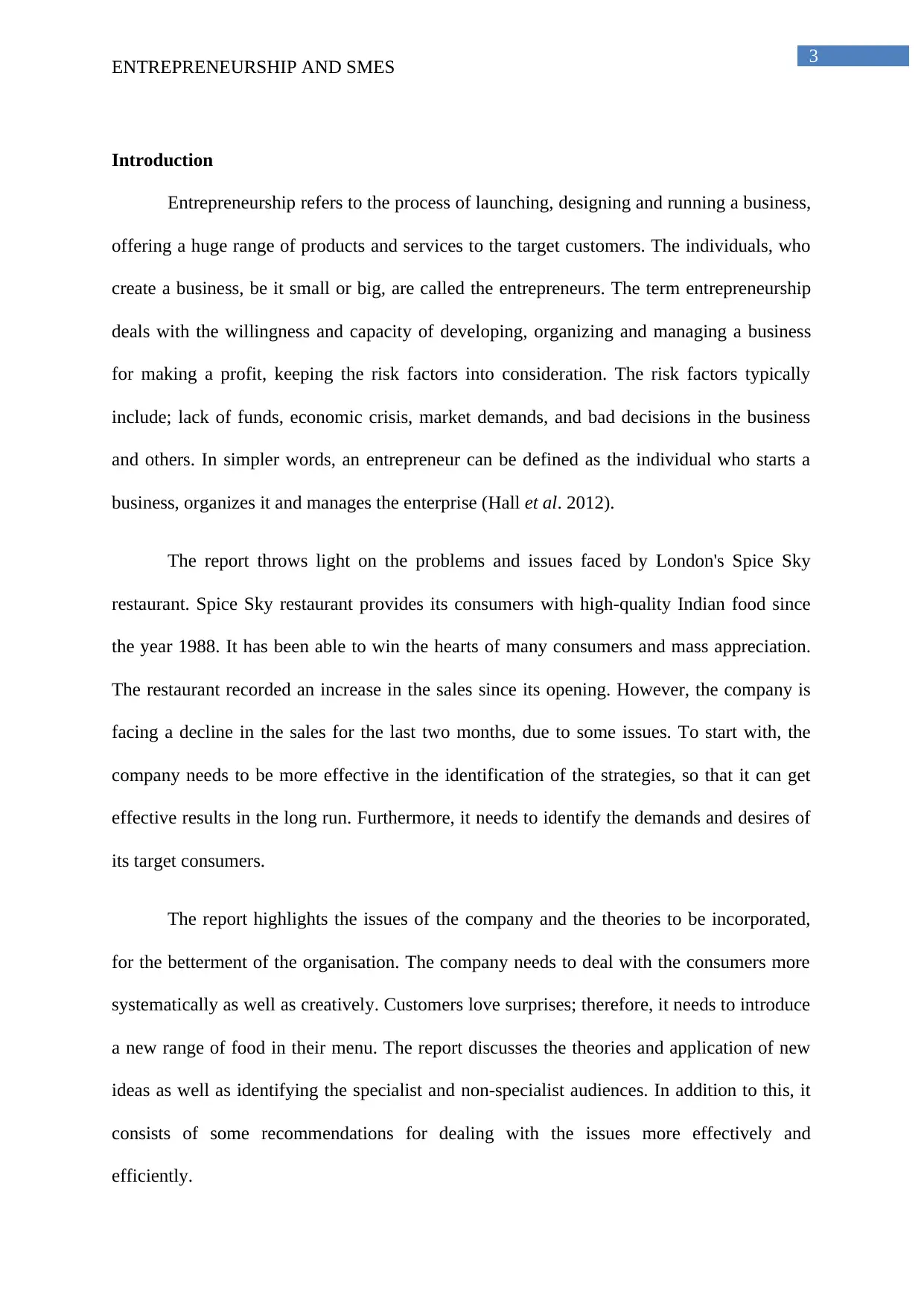
3
ENTREPRENEURSHIP AND SMES
Introduction
Entrepreneurship refers to the process of launching, designing and running a business,
offering a huge range of products and services to the target customers. The individuals, who
create a business, be it small or big, are called the entrepreneurs. The term entrepreneurship
deals with the willingness and capacity of developing, organizing and managing a business
for making a profit, keeping the risk factors into consideration. The risk factors typically
include; lack of funds, economic crisis, market demands, and bad decisions in the business
and others. In simpler words, an entrepreneur can be defined as the individual who starts a
business, organizes it and manages the enterprise (Hall et al. 2012).
The report throws light on the problems and issues faced by London's Spice Sky
restaurant. Spice Sky restaurant provides its consumers with high-quality Indian food since
the year 1988. It has been able to win the hearts of many consumers and mass appreciation.
The restaurant recorded an increase in the sales since its opening. However, the company is
facing a decline in the sales for the last two months, due to some issues. To start with, the
company needs to be more effective in the identification of the strategies, so that it can get
effective results in the long run. Furthermore, it needs to identify the demands and desires of
its target consumers.
The report highlights the issues of the company and the theories to be incorporated,
for the betterment of the organisation. The company needs to deal with the consumers more
systematically as well as creatively. Customers love surprises; therefore, it needs to introduce
a new range of food in their menu. The report discusses the theories and application of new
ideas as well as identifying the specialist and non-specialist audiences. In addition to this, it
consists of some recommendations for dealing with the issues more effectively and
efficiently.
ENTREPRENEURSHIP AND SMES
Introduction
Entrepreneurship refers to the process of launching, designing and running a business,
offering a huge range of products and services to the target customers. The individuals, who
create a business, be it small or big, are called the entrepreneurs. The term entrepreneurship
deals with the willingness and capacity of developing, organizing and managing a business
for making a profit, keeping the risk factors into consideration. The risk factors typically
include; lack of funds, economic crisis, market demands, and bad decisions in the business
and others. In simpler words, an entrepreneur can be defined as the individual who starts a
business, organizes it and manages the enterprise (Hall et al. 2012).
The report throws light on the problems and issues faced by London's Spice Sky
restaurant. Spice Sky restaurant provides its consumers with high-quality Indian food since
the year 1988. It has been able to win the hearts of many consumers and mass appreciation.
The restaurant recorded an increase in the sales since its opening. However, the company is
facing a decline in the sales for the last two months, due to some issues. To start with, the
company needs to be more effective in the identification of the strategies, so that it can get
effective results in the long run. Furthermore, it needs to identify the demands and desires of
its target consumers.
The report highlights the issues of the company and the theories to be incorporated,
for the betterment of the organisation. The company needs to deal with the consumers more
systematically as well as creatively. Customers love surprises; therefore, it needs to introduce
a new range of food in their menu. The report discusses the theories and application of new
ideas as well as identifying the specialist and non-specialist audiences. In addition to this, it
consists of some recommendations for dealing with the issues more effectively and
efficiently.
Paraphrase This Document
Need a fresh take? Get an instant paraphrase of this document with our AI Paraphraser
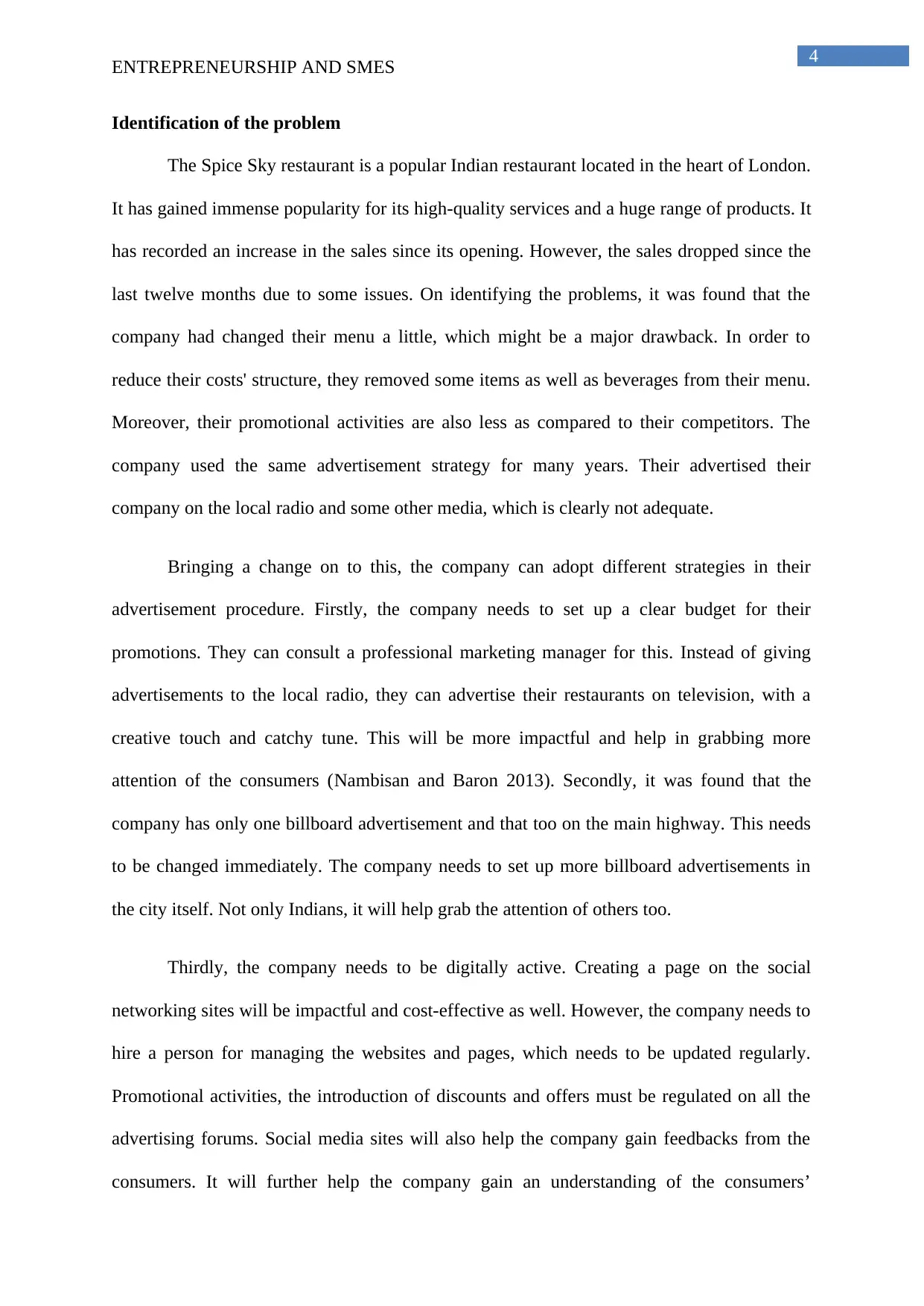
4
ENTREPRENEURSHIP AND SMES
Identification of the problem
The Spice Sky restaurant is a popular Indian restaurant located in the heart of London.
It has gained immense popularity for its high-quality services and a huge range of products. It
has recorded an increase in the sales since its opening. However, the sales dropped since the
last twelve months due to some issues. On identifying the problems, it was found that the
company had changed their menu a little, which might be a major drawback. In order to
reduce their costs' structure, they removed some items as well as beverages from their menu.
Moreover, their promotional activities are also less as compared to their competitors. The
company used the same advertisement strategy for many years. Their advertised their
company on the local radio and some other media, which is clearly not adequate.
Bringing a change on to this, the company can adopt different strategies in their
advertisement procedure. Firstly, the company needs to set up a clear budget for their
promotions. They can consult a professional marketing manager for this. Instead of giving
advertisements to the local radio, they can advertise their restaurants on television, with a
creative touch and catchy tune. This will be more impactful and help in grabbing more
attention of the consumers (Nambisan and Baron 2013). Secondly, it was found that the
company has only one billboard advertisement and that too on the main highway. This needs
to be changed immediately. The company needs to set up more billboard advertisements in
the city itself. Not only Indians, it will help grab the attention of others too.
Thirdly, the company needs to be digitally active. Creating a page on the social
networking sites will be impactful and cost-effective as well. However, the company needs to
hire a person for managing the websites and pages, which needs to be updated regularly.
Promotional activities, the introduction of discounts and offers must be regulated on all the
advertising forums. Social media sites will also help the company gain feedbacks from the
consumers. It will further help the company gain an understanding of the consumers’
ENTREPRENEURSHIP AND SMES
Identification of the problem
The Spice Sky restaurant is a popular Indian restaurant located in the heart of London.
It has gained immense popularity for its high-quality services and a huge range of products. It
has recorded an increase in the sales since its opening. However, the sales dropped since the
last twelve months due to some issues. On identifying the problems, it was found that the
company had changed their menu a little, which might be a major drawback. In order to
reduce their costs' structure, they removed some items as well as beverages from their menu.
Moreover, their promotional activities are also less as compared to their competitors. The
company used the same advertisement strategy for many years. Their advertised their
company on the local radio and some other media, which is clearly not adequate.
Bringing a change on to this, the company can adopt different strategies in their
advertisement procedure. Firstly, the company needs to set up a clear budget for their
promotions. They can consult a professional marketing manager for this. Instead of giving
advertisements to the local radio, they can advertise their restaurants on television, with a
creative touch and catchy tune. This will be more impactful and help in grabbing more
attention of the consumers (Nambisan and Baron 2013). Secondly, it was found that the
company has only one billboard advertisement and that too on the main highway. This needs
to be changed immediately. The company needs to set up more billboard advertisements in
the city itself. Not only Indians, it will help grab the attention of others too.
Thirdly, the company needs to be digitally active. Creating a page on the social
networking sites will be impactful and cost-effective as well. However, the company needs to
hire a person for managing the websites and pages, which needs to be updated regularly.
Promotional activities, the introduction of discounts and offers must be regulated on all the
advertising forums. Social media sites will also help the company gain feedbacks from the
consumers. It will further help the company gain an understanding of the consumers’
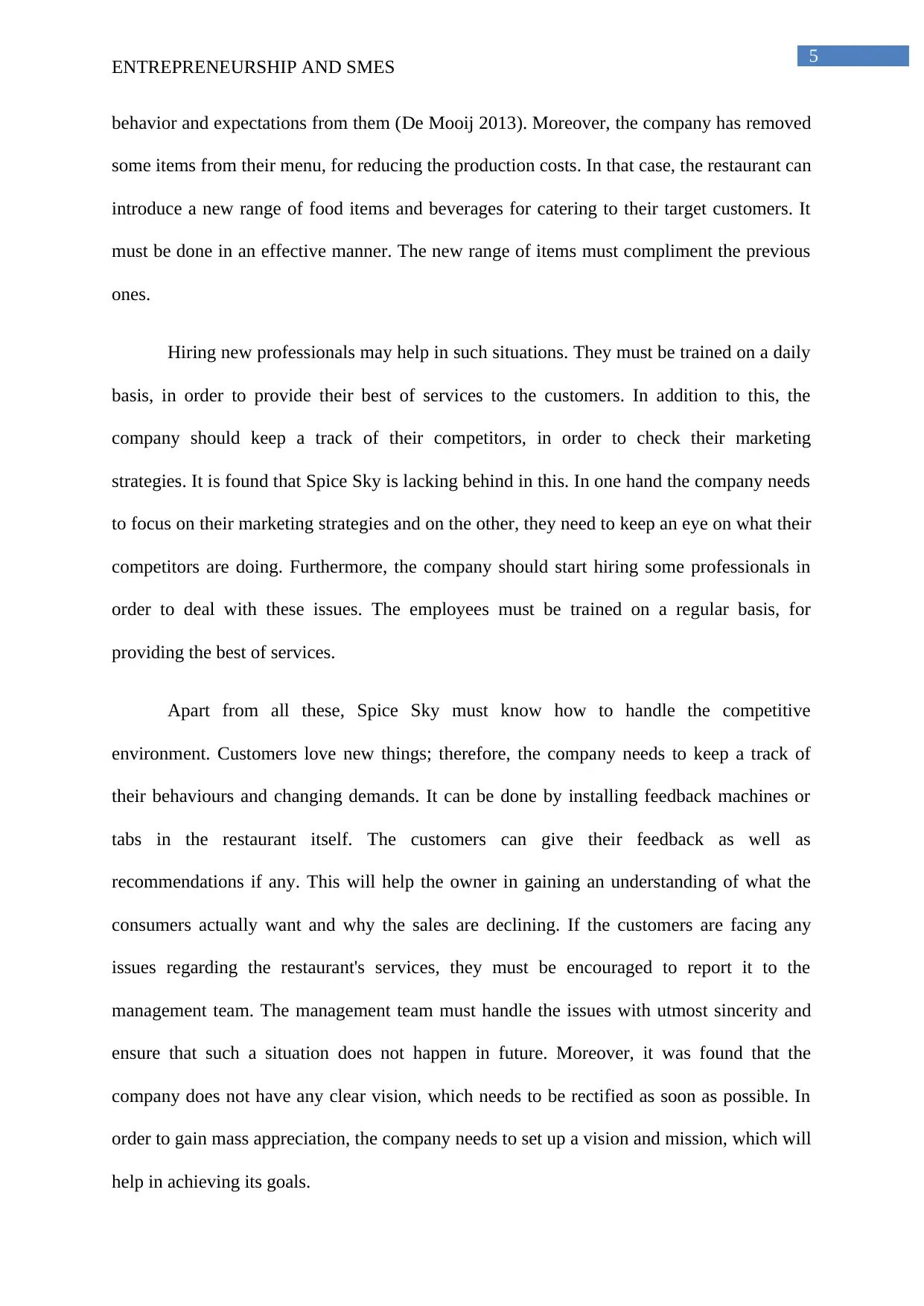
5
ENTREPRENEURSHIP AND SMES
behavior and expectations from them (De Mooij 2013). Moreover, the company has removed
some items from their menu, for reducing the production costs. In that case, the restaurant can
introduce a new range of food items and beverages for catering to their target customers. It
must be done in an effective manner. The new range of items must compliment the previous
ones.
Hiring new professionals may help in such situations. They must be trained on a daily
basis, in order to provide their best of services to the customers. In addition to this, the
company should keep a track of their competitors, in order to check their marketing
strategies. It is found that Spice Sky is lacking behind in this. In one hand the company needs
to focus on their marketing strategies and on the other, they need to keep an eye on what their
competitors are doing. Furthermore, the company should start hiring some professionals in
order to deal with these issues. The employees must be trained on a regular basis, for
providing the best of services.
Apart from all these, Spice Sky must know how to handle the competitive
environment. Customers love new things; therefore, the company needs to keep a track of
their behaviours and changing demands. It can be done by installing feedback machines or
tabs in the restaurant itself. The customers can give their feedback as well as
recommendations if any. This will help the owner in gaining an understanding of what the
consumers actually want and why the sales are declining. If the customers are facing any
issues regarding the restaurant's services, they must be encouraged to report it to the
management team. The management team must handle the issues with utmost sincerity and
ensure that such a situation does not happen in future. Moreover, it was found that the
company does not have any clear vision, which needs to be rectified as soon as possible. In
order to gain mass appreciation, the company needs to set up a vision and mission, which will
help in achieving its goals.
ENTREPRENEURSHIP AND SMES
behavior and expectations from them (De Mooij 2013). Moreover, the company has removed
some items from their menu, for reducing the production costs. In that case, the restaurant can
introduce a new range of food items and beverages for catering to their target customers. It
must be done in an effective manner. The new range of items must compliment the previous
ones.
Hiring new professionals may help in such situations. They must be trained on a daily
basis, in order to provide their best of services to the customers. In addition to this, the
company should keep a track of their competitors, in order to check their marketing
strategies. It is found that Spice Sky is lacking behind in this. In one hand the company needs
to focus on their marketing strategies and on the other, they need to keep an eye on what their
competitors are doing. Furthermore, the company should start hiring some professionals in
order to deal with these issues. The employees must be trained on a regular basis, for
providing the best of services.
Apart from all these, Spice Sky must know how to handle the competitive
environment. Customers love new things; therefore, the company needs to keep a track of
their behaviours and changing demands. It can be done by installing feedback machines or
tabs in the restaurant itself. The customers can give their feedback as well as
recommendations if any. This will help the owner in gaining an understanding of what the
consumers actually want and why the sales are declining. If the customers are facing any
issues regarding the restaurant's services, they must be encouraged to report it to the
management team. The management team must handle the issues with utmost sincerity and
ensure that such a situation does not happen in future. Moreover, it was found that the
company does not have any clear vision, which needs to be rectified as soon as possible. In
order to gain mass appreciation, the company needs to set up a vision and mission, which will
help in achieving its goals.
⊘ This is a preview!⊘
Do you want full access?
Subscribe today to unlock all pages.

Trusted by 1+ million students worldwide
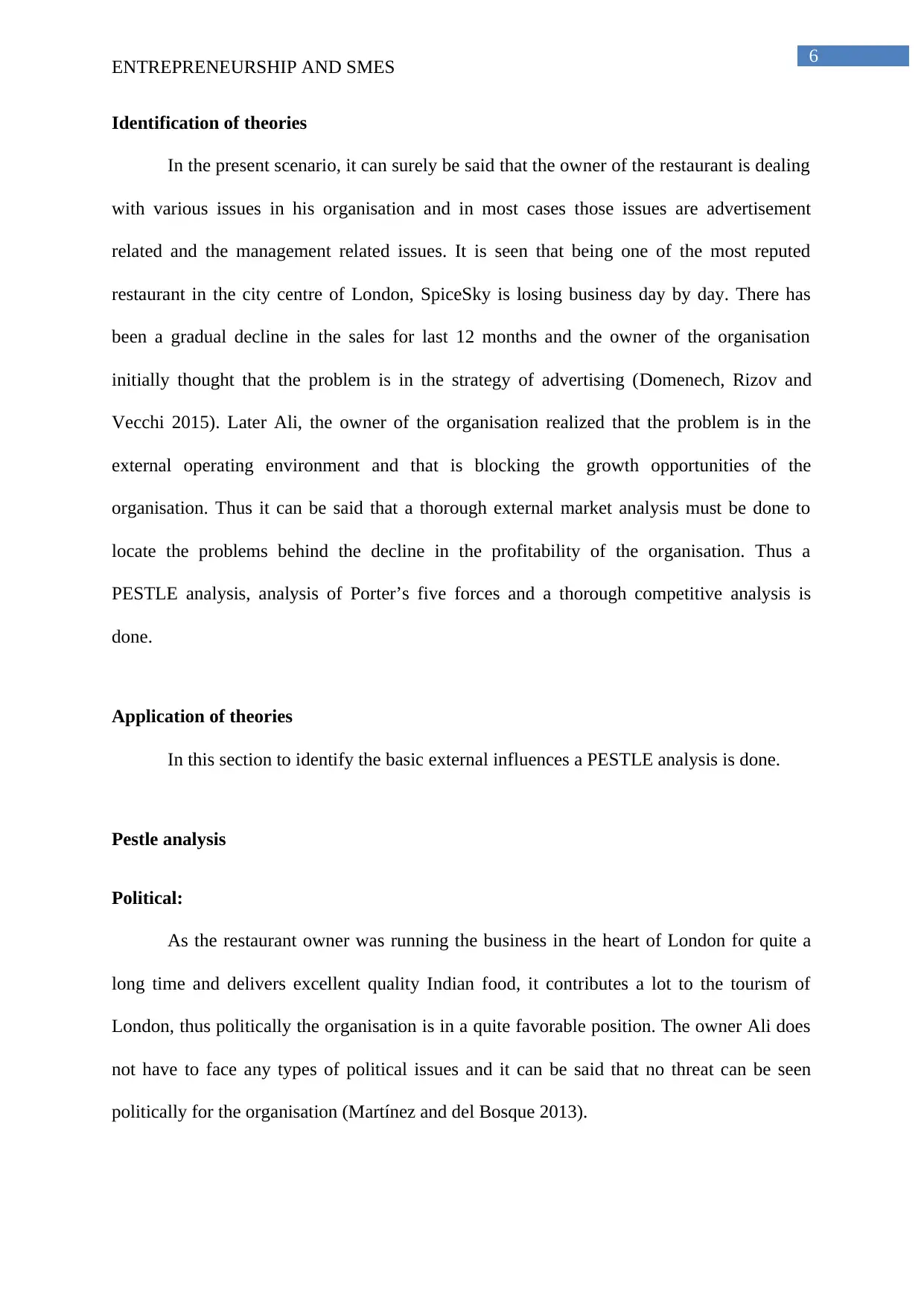
6
ENTREPRENEURSHIP AND SMES
Identification of theories
In the present scenario, it can surely be said that the owner of the restaurant is dealing
with various issues in his organisation and in most cases those issues are advertisement
related and the management related issues. It is seen that being one of the most reputed
restaurant in the city centre of London, SpiceSky is losing business day by day. There has
been a gradual decline in the sales for last 12 months and the owner of the organisation
initially thought that the problem is in the strategy of advertising (Domenech, Rizov and
Vecchi 2015). Later Ali, the owner of the organisation realized that the problem is in the
external operating environment and that is blocking the growth opportunities of the
organisation. Thus it can be said that a thorough external market analysis must be done to
locate the problems behind the decline in the profitability of the organisation. Thus a
PESTLE analysis, analysis of Porter’s five forces and a thorough competitive analysis is
done.
Application of theories
In this section to identify the basic external influences a PESTLE analysis is done.
Pestle analysis
Political:
As the restaurant owner was running the business in the heart of London for quite a
long time and delivers excellent quality Indian food, it contributes a lot to the tourism of
London, thus politically the organisation is in a quite favorable position. The owner Ali does
not have to face any types of political issues and it can be said that no threat can be seen
politically for the organisation (Martínez and del Bosque 2013).
ENTREPRENEURSHIP AND SMES
Identification of theories
In the present scenario, it can surely be said that the owner of the restaurant is dealing
with various issues in his organisation and in most cases those issues are advertisement
related and the management related issues. It is seen that being one of the most reputed
restaurant in the city centre of London, SpiceSky is losing business day by day. There has
been a gradual decline in the sales for last 12 months and the owner of the organisation
initially thought that the problem is in the strategy of advertising (Domenech, Rizov and
Vecchi 2015). Later Ali, the owner of the organisation realized that the problem is in the
external operating environment and that is blocking the growth opportunities of the
organisation. Thus it can be said that a thorough external market analysis must be done to
locate the problems behind the decline in the profitability of the organisation. Thus a
PESTLE analysis, analysis of Porter’s five forces and a thorough competitive analysis is
done.
Application of theories
In this section to identify the basic external influences a PESTLE analysis is done.
Pestle analysis
Political:
As the restaurant owner was running the business in the heart of London for quite a
long time and delivers excellent quality Indian food, it contributes a lot to the tourism of
London, thus politically the organisation is in a quite favorable position. The owner Ali does
not have to face any types of political issues and it can be said that no threat can be seen
politically for the organisation (Martínez and del Bosque 2013).
Paraphrase This Document
Need a fresh take? Get an instant paraphrase of this document with our AI Paraphraser
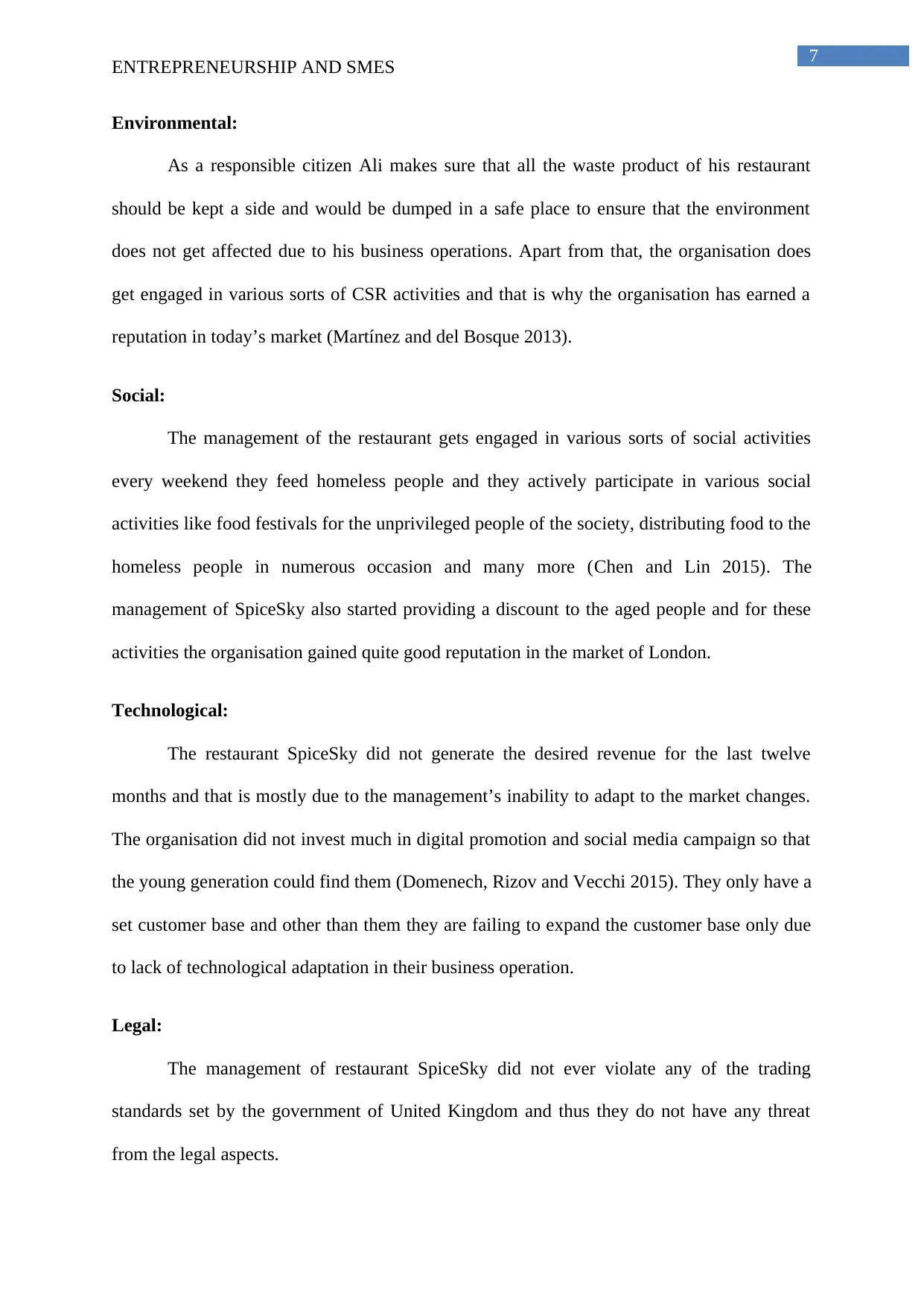
7
ENTREPRENEURSHIP AND SMES
Environmental:
As a responsible citizen Ali makes sure that all the waste product of his restaurant
should be kept a side and would be dumped in a safe place to ensure that the environment
does not get affected due to his business operations. Apart from that, the organisation does
get engaged in various sorts of CSR activities and that is why the organisation has earned a
reputation in today’s market (Martínez and del Bosque 2013).
Social:
The management of the restaurant gets engaged in various sorts of social activities
every weekend they feed homeless people and they actively participate in various social
activities like food festivals for the unprivileged people of the society, distributing food to the
homeless people in numerous occasion and many more (Chen and Lin 2015). The
management of SpiceSky also started providing a discount to the aged people and for these
activities the organisation gained quite good reputation in the market of London.
Technological:
The restaurant SpiceSky did not generate the desired revenue for the last twelve
months and that is mostly due to the management’s inability to adapt to the market changes.
The organisation did not invest much in digital promotion and social media campaign so that
the young generation could find them (Domenech, Rizov and Vecchi 2015). They only have a
set customer base and other than them they are failing to expand the customer base only due
to lack of technological adaptation in their business operation.
Legal:
The management of restaurant SpiceSky did not ever violate any of the trading
standards set by the government of United Kingdom and thus they do not have any threat
from the legal aspects.
ENTREPRENEURSHIP AND SMES
Environmental:
As a responsible citizen Ali makes sure that all the waste product of his restaurant
should be kept a side and would be dumped in a safe place to ensure that the environment
does not get affected due to his business operations. Apart from that, the organisation does
get engaged in various sorts of CSR activities and that is why the organisation has earned a
reputation in today’s market (Martínez and del Bosque 2013).
Social:
The management of the restaurant gets engaged in various sorts of social activities
every weekend they feed homeless people and they actively participate in various social
activities like food festivals for the unprivileged people of the society, distributing food to the
homeless people in numerous occasion and many more (Chen and Lin 2015). The
management of SpiceSky also started providing a discount to the aged people and for these
activities the organisation gained quite good reputation in the market of London.
Technological:
The restaurant SpiceSky did not generate the desired revenue for the last twelve
months and that is mostly due to the management’s inability to adapt to the market changes.
The organisation did not invest much in digital promotion and social media campaign so that
the young generation could find them (Domenech, Rizov and Vecchi 2015). They only have a
set customer base and other than them they are failing to expand the customer base only due
to lack of technological adaptation in their business operation.
Legal:
The management of restaurant SpiceSky did not ever violate any of the trading
standards set by the government of United Kingdom and thus they do not have any threat
from the legal aspects.
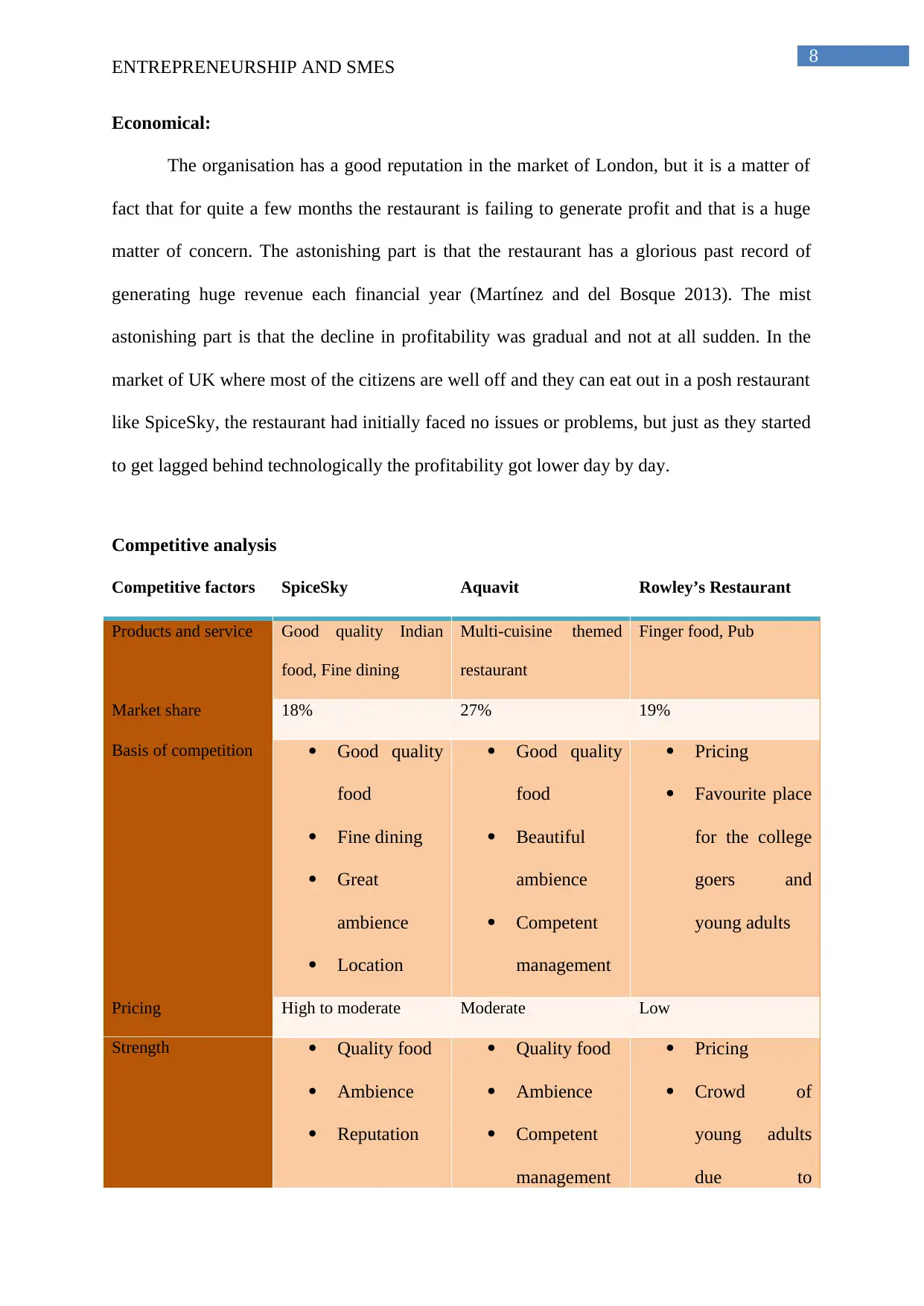
8
ENTREPRENEURSHIP AND SMES
Economical:
The organisation has a good reputation in the market of London, but it is a matter of
fact that for quite a few months the restaurant is failing to generate profit and that is a huge
matter of concern. The astonishing part is that the restaurant has a glorious past record of
generating huge revenue each financial year (Martínez and del Bosque 2013). The mist
astonishing part is that the decline in profitability was gradual and not at all sudden. In the
market of UK where most of the citizens are well off and they can eat out in a posh restaurant
like SpiceSky, the restaurant had initially faced no issues or problems, but just as they started
to get lagged behind technologically the profitability got lower day by day.
Competitive analysis
Competitive factors SpiceSky Aquavit Rowley’s Restaurant
Products and service Good quality Indian
food, Fine dining
Multi-cuisine themed
restaurant
Finger food, Pub
Market share 18% 27% 19%
Basis of competition Good quality
food
Fine dining
Great
ambience
Location
Good quality
food
Beautiful
ambience
Competent
management
Pricing
Favourite place
for the college
goers and
young adults
Pricing High to moderate Moderate Low
Strength Quality food
Ambience
Reputation
Quality food
Ambience
Competent
management
Pricing
Crowd of
young adults
due to
ENTREPRENEURSHIP AND SMES
Economical:
The organisation has a good reputation in the market of London, but it is a matter of
fact that for quite a few months the restaurant is failing to generate profit and that is a huge
matter of concern. The astonishing part is that the restaurant has a glorious past record of
generating huge revenue each financial year (Martínez and del Bosque 2013). The mist
astonishing part is that the decline in profitability was gradual and not at all sudden. In the
market of UK where most of the citizens are well off and they can eat out in a posh restaurant
like SpiceSky, the restaurant had initially faced no issues or problems, but just as they started
to get lagged behind technologically the profitability got lower day by day.
Competitive analysis
Competitive factors SpiceSky Aquavit Rowley’s Restaurant
Products and service Good quality Indian
food, Fine dining
Multi-cuisine themed
restaurant
Finger food, Pub
Market share 18% 27% 19%
Basis of competition Good quality
food
Fine dining
Great
ambience
Location
Good quality
food
Beautiful
ambience
Competent
management
Pricing
Favourite place
for the college
goers and
young adults
Pricing High to moderate Moderate Low
Strength Quality food
Ambience
Reputation
Quality food
Ambience
Competent
management
Pricing
Crowd of
young adults
due to
⊘ This is a preview!⊘
Do you want full access?
Subscribe today to unlock all pages.

Trusted by 1+ million students worldwide
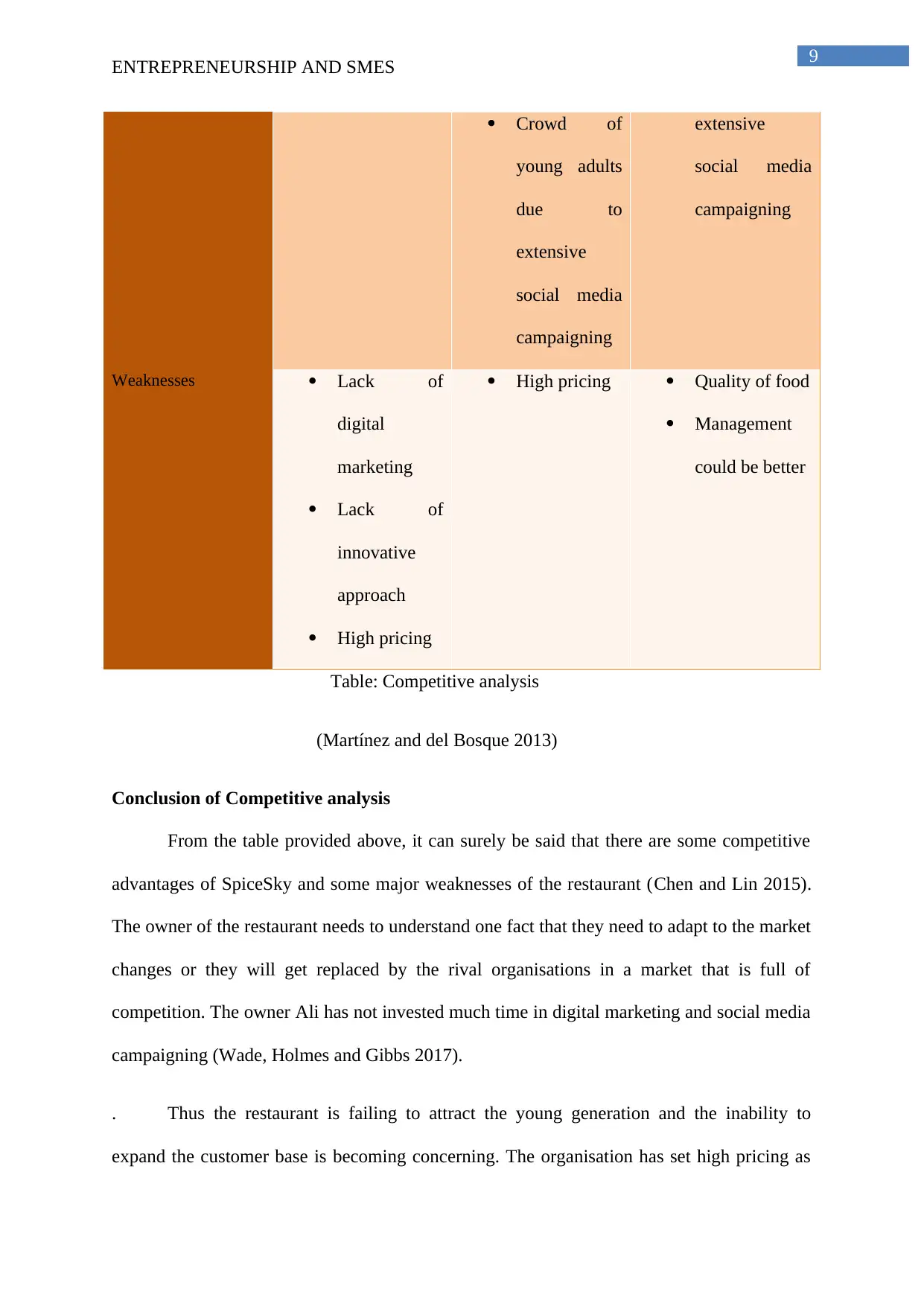
9
ENTREPRENEURSHIP AND SMES
Crowd of
young adults
due to
extensive
social media
campaigning
extensive
social media
campaigning
Weaknesses Lack of
digital
marketing
Lack of
innovative
approach
High pricing
High pricing Quality of food
Management
could be better
Table: Competitive analysis
(Martínez and del Bosque 2013)
Conclusion of Competitive analysis
From the table provided above, it can surely be said that there are some competitive
advantages of SpiceSky and some major weaknesses of the restaurant (Chen and Lin 2015).
The owner of the restaurant needs to understand one fact that they need to adapt to the market
changes or they will get replaced by the rival organisations in a market that is full of
competition. The owner Ali has not invested much time in digital marketing and social media
campaigning (Wade, Holmes and Gibbs 2017).
. Thus the restaurant is failing to attract the young generation and the inability to
expand the customer base is becoming concerning. The organisation has set high pricing as
ENTREPRENEURSHIP AND SMES
Crowd of
young adults
due to
extensive
social media
campaigning
extensive
social media
campaigning
Weaknesses Lack of
digital
marketing
Lack of
innovative
approach
High pricing
High pricing Quality of food
Management
could be better
Table: Competitive analysis
(Martínez and del Bosque 2013)
Conclusion of Competitive analysis
From the table provided above, it can surely be said that there are some competitive
advantages of SpiceSky and some major weaknesses of the restaurant (Chen and Lin 2015).
The owner of the restaurant needs to understand one fact that they need to adapt to the market
changes or they will get replaced by the rival organisations in a market that is full of
competition. The owner Ali has not invested much time in digital marketing and social media
campaigning (Wade, Holmes and Gibbs 2017).
. Thus the restaurant is failing to attract the young generation and the inability to
expand the customer base is becoming concerning. The organisation has set high pricing as
Paraphrase This Document
Need a fresh take? Get an instant paraphrase of this document with our AI Paraphraser
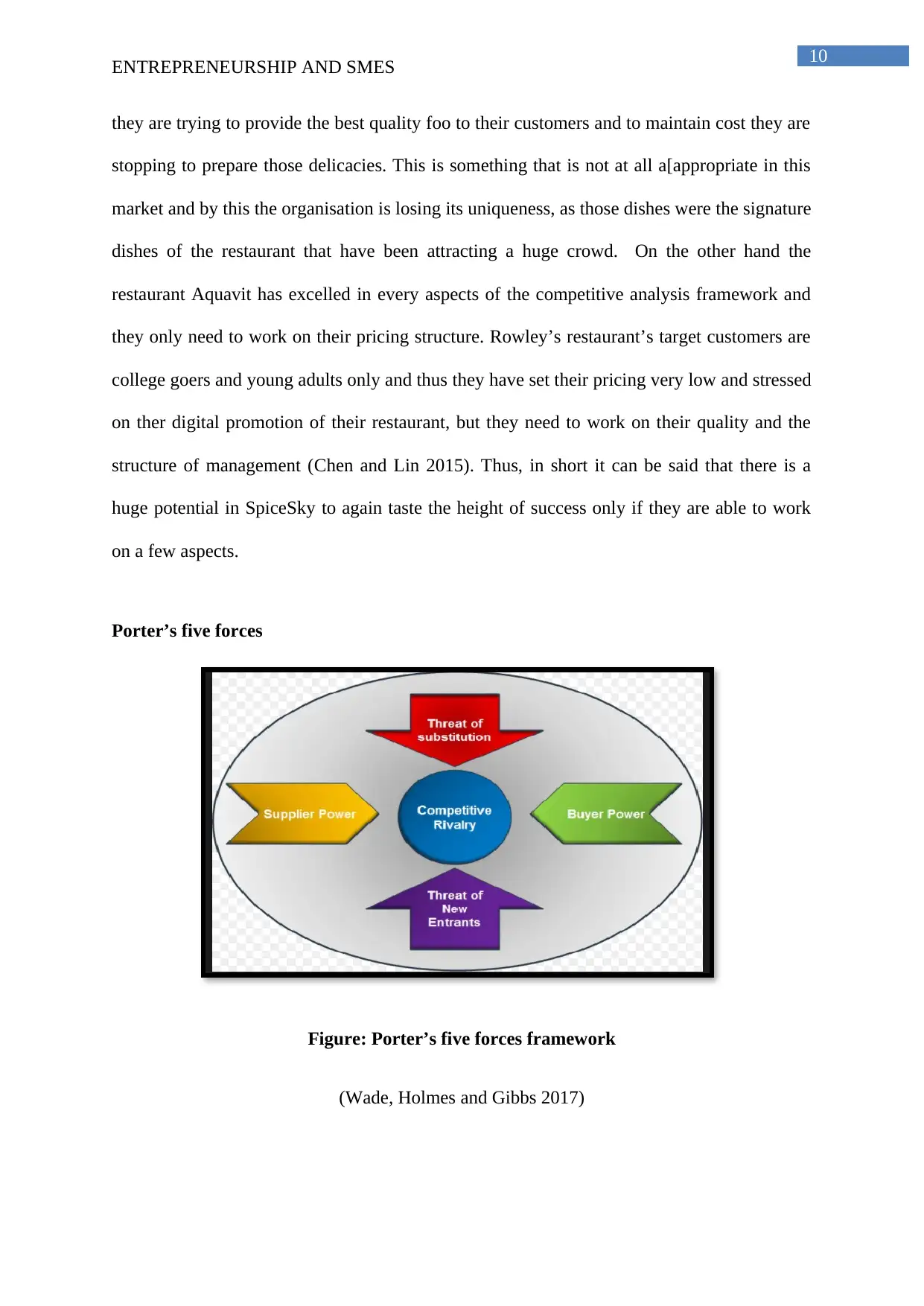
10
ENTREPRENEURSHIP AND SMES
they are trying to provide the best quality foo to their customers and to maintain cost they are
stopping to prepare those delicacies. This is something that is not at all a[appropriate in this
market and by this the organisation is losing its uniqueness, as those dishes were the signature
dishes of the restaurant that have been attracting a huge crowd. On the other hand the
restaurant Aquavit has excelled in every aspects of the competitive analysis framework and
they only need to work on their pricing structure. Rowley’s restaurant’s target customers are
college goers and young adults only and thus they have set their pricing very low and stressed
on ther digital promotion of their restaurant, but they need to work on their quality and the
structure of management (Chen and Lin 2015). Thus, in short it can be said that there is a
huge potential in SpiceSky to again taste the height of success only if they are able to work
on a few aspects.
Porter’s five forces
Figure: Porter’s five forces framework
(Wade, Holmes and Gibbs 2017)
ENTREPRENEURSHIP AND SMES
they are trying to provide the best quality foo to their customers and to maintain cost they are
stopping to prepare those delicacies. This is something that is not at all a[appropriate in this
market and by this the organisation is losing its uniqueness, as those dishes were the signature
dishes of the restaurant that have been attracting a huge crowd. On the other hand the
restaurant Aquavit has excelled in every aspects of the competitive analysis framework and
they only need to work on their pricing structure. Rowley’s restaurant’s target customers are
college goers and young adults only and thus they have set their pricing very low and stressed
on ther digital promotion of their restaurant, but they need to work on their quality and the
structure of management (Chen and Lin 2015). Thus, in short it can be said that there is a
huge potential in SpiceSky to again taste the height of success only if they are able to work
on a few aspects.
Porter’s five forces
Figure: Porter’s five forces framework
(Wade, Holmes and Gibbs 2017)
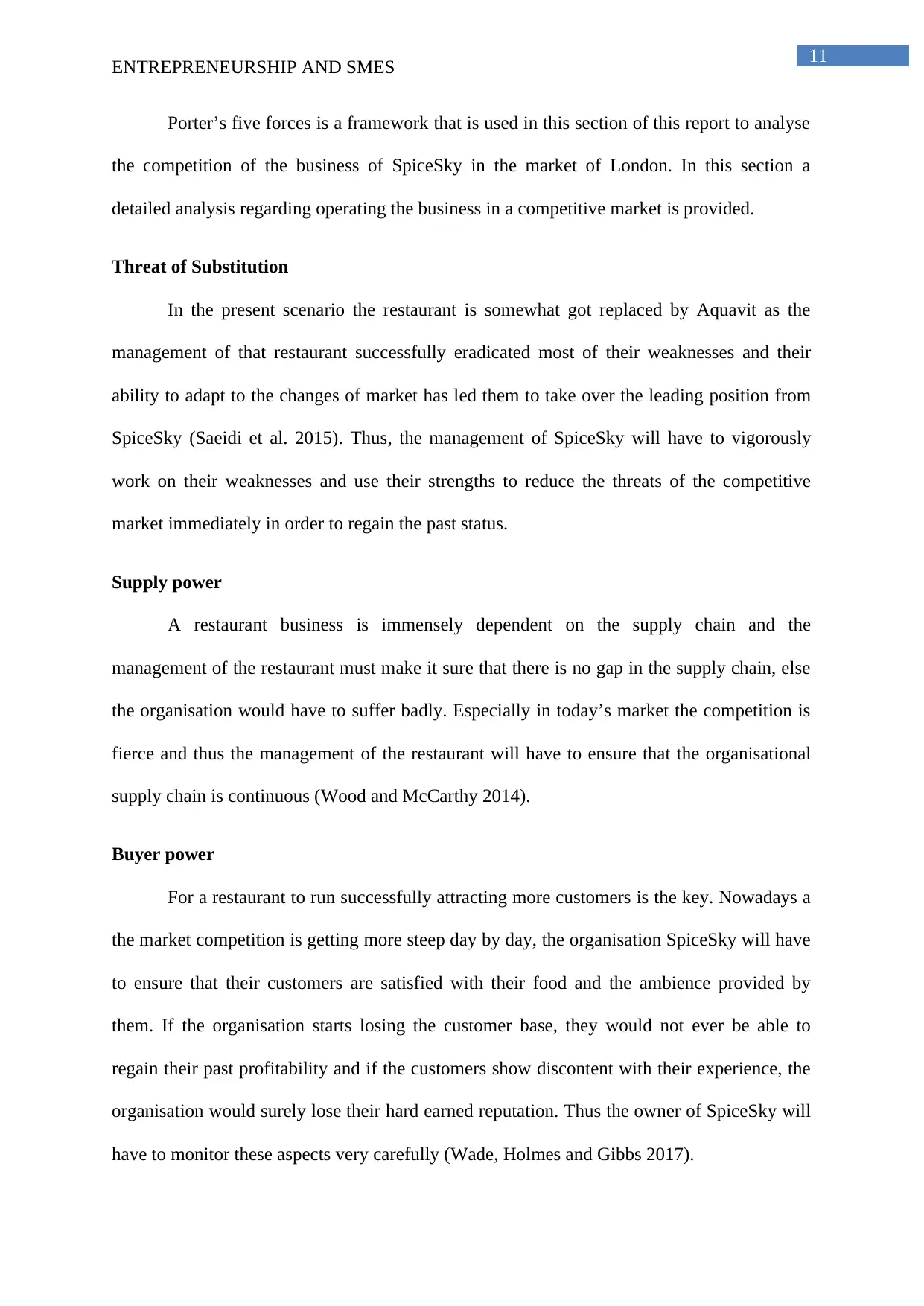
11
ENTREPRENEURSHIP AND SMES
Porter’s five forces is a framework that is used in this section of this report to analyse
the competition of the business of SpiceSky in the market of London. In this section a
detailed analysis regarding operating the business in a competitive market is provided.
Threat of Substitution
In the present scenario the restaurant is somewhat got replaced by Aquavit as the
management of that restaurant successfully eradicated most of their weaknesses and their
ability to adapt to the changes of market has led them to take over the leading position from
SpiceSky (Saeidi et al. 2015). Thus, the management of SpiceSky will have to vigorously
work on their weaknesses and use their strengths to reduce the threats of the competitive
market immediately in order to regain the past status.
Supply power
A restaurant business is immensely dependent on the supply chain and the
management of the restaurant must make it sure that there is no gap in the supply chain, else
the organisation would have to suffer badly. Especially in today’s market the competition is
fierce and thus the management of the restaurant will have to ensure that the organisational
supply chain is continuous (Wood and McCarthy 2014).
Buyer power
For a restaurant to run successfully attracting more customers is the key. Nowadays a
the market competition is getting more steep day by day, the organisation SpiceSky will have
to ensure that their customers are satisfied with their food and the ambience provided by
them. If the organisation starts losing the customer base, they would not ever be able to
regain their past profitability and if the customers show discontent with their experience, the
organisation would surely lose their hard earned reputation. Thus the owner of SpiceSky will
have to monitor these aspects very carefully (Wade, Holmes and Gibbs 2017).
ENTREPRENEURSHIP AND SMES
Porter’s five forces is a framework that is used in this section of this report to analyse
the competition of the business of SpiceSky in the market of London. In this section a
detailed analysis regarding operating the business in a competitive market is provided.
Threat of Substitution
In the present scenario the restaurant is somewhat got replaced by Aquavit as the
management of that restaurant successfully eradicated most of their weaknesses and their
ability to adapt to the changes of market has led them to take over the leading position from
SpiceSky (Saeidi et al. 2015). Thus, the management of SpiceSky will have to vigorously
work on their weaknesses and use their strengths to reduce the threats of the competitive
market immediately in order to regain the past status.
Supply power
A restaurant business is immensely dependent on the supply chain and the
management of the restaurant must make it sure that there is no gap in the supply chain, else
the organisation would have to suffer badly. Especially in today’s market the competition is
fierce and thus the management of the restaurant will have to ensure that the organisational
supply chain is continuous (Wood and McCarthy 2014).
Buyer power
For a restaurant to run successfully attracting more customers is the key. Nowadays a
the market competition is getting more steep day by day, the organisation SpiceSky will have
to ensure that their customers are satisfied with their food and the ambience provided by
them. If the organisation starts losing the customer base, they would not ever be able to
regain their past profitability and if the customers show discontent with their experience, the
organisation would surely lose their hard earned reputation. Thus the owner of SpiceSky will
have to monitor these aspects very carefully (Wade, Holmes and Gibbs 2017).
⊘ This is a preview!⊘
Do you want full access?
Subscribe today to unlock all pages.

Trusted by 1+ million students worldwide
1 out of 21
Related Documents
Your All-in-One AI-Powered Toolkit for Academic Success.
+13062052269
info@desklib.com
Available 24*7 on WhatsApp / Email
![[object Object]](/_next/static/media/star-bottom.7253800d.svg)
Unlock your academic potential
Copyright © 2020–2025 A2Z Services. All Rights Reserved. Developed and managed by ZUCOL.





